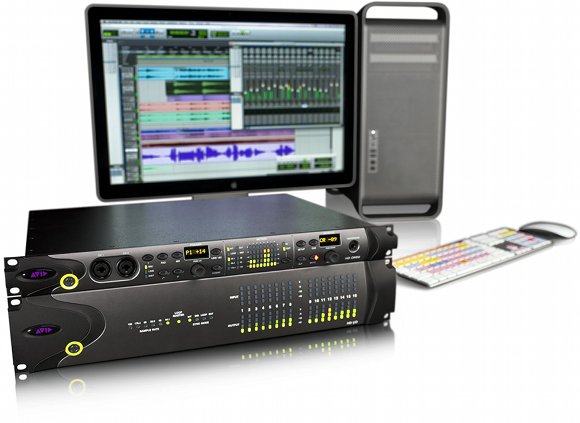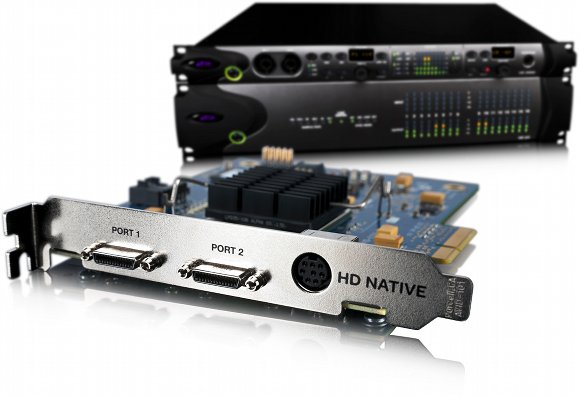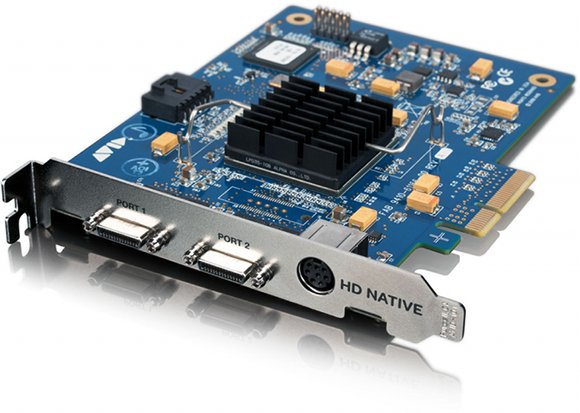
For some time, the move has seemed inevitable – even more so as the rumor mill started echoing with suggestions that a native release was coming. But now, it’s happened: Pro Tools HD will now run without HD DSP hardware. And that’s not all — you can also use the same hardware with your existing DAW of choice, for users of software like Cubase and Logic.
There’s a price tag attached, though. This remains what for many would be a high-end solution. At US$3495 retail and up, it’s not competition for buying a basic interface card and Cubase. Think, instead, a more affordable and flexible way to equip studio rigs, and some potentially serious competition for vendors like Apogee, especially since you can use any DAW you want.
Just to say that again: Avid is making a version of Pro Tools HD that runs on the CPU and supports any DAW on Windows 7 or Mac OS X Snow Leopard and higher.
The AIR (Avid) user blog has some terrific analysis on the announcement even before it became public, comparing leaked price info for Native to an Apogee rig. If you haven’t been reading the AIR blog, they’ve hardly been shills for Avid; they’ve savaged some of the company’s decisions. And they’re actually pretty positive here. (Spoiler: Avid winds up being cheaper than Apogee by a few hundred bucks in their calculus.)
Is An Avid Pro Tools HD Native Core System Expensive?
What you get for that investment, though, is something worth discussing. It also reveals what’s necessary to get real, low-latency audio operation, which is relevant even if you aren’t in the market for Pro Tools|HD Native. CDM gets some insight into that from the developers.
First, Pro Tools|HD Native at a glance. Bundles:
Native core: $3495 buys you the necessary PCIe native card plus Pro Tools HD 8.5 software. The card comes with two Digilink mini ports on it.
Native core + OMNI Add an HD OMNI interface to the above. Total: US$5995.
Native core + HD I/O 8x8x8 Get a full 8x8x8 HD I/O interface. Total cost: US$6995.
Native core + HD I/O 16×16 analog US$7995.
Availability: November 4.
So, why bother with “HD Native” when there are versions like LE? The difference is that some of the more serious studio features remain:
- Surround, VCA mixing
- Destructive/track punch, advanced automation
- Solo Bus AFL/PFL, track-based input monitoring
- Sync HD support
- 9-pin Machine Control
- Venue support. (Yeah, that’s pretty huge, since Venue rigs don’t necessarily need all the TDM stuff.

This isn’t a TDM solution, though, so you don’t get TDM plug-in support, which for many is one of the big draws of Pro Tools. That includes the recently-announced HEAT, an analog-modeling sonic sweetener based on the qualities of tape. (There’s more to say about HEAT; I just got off the phone with its talented designer Dave Hill, so expect the results of that interview soon.)
It is a significant “mid-range” studio solution, and will likely fill a big need for Pro Tools customers. Avid told CDM in a briefing yesterday that they’ve gotten enormous demand for just such a solution. Just doing a discounted upgrade to HD got a big response, and users have wanted something between LE and the TDM-based HD for project or secondary studios. It also seems to me that it demonstrates Avid is willing to change, which could have greater implications down the road.
What you get is, says Avid, not a replacement for their DSP solutions, but otherwise unrestricted in sync, I/O, and functionality. It has the mixing and I/O LE lacks, and it even supports legacy “blue” HD converters (192, etc.), making it a likely candidate for upgrading studio setups that didn’t make the leap to 8.5 software.
If you don’t want to use Pro Tools as your DAW, you get 64 channels of I/O with any Core Audio (Mac) or ASIO (PC) system. Avid says they’ve tested extensively with Logic and Nuendo; Digital Performer, SONAR, and others should work, too.
And, notably, it’s a native system with extraordinarily low latency. Pro Tools|HD does .44 ms (at 96k and a 64 sample — yes, sixty-four total – buffer). But HD Native does a very respectable 1.6 ms; less than half that if you choose direct monitoring while recording, which you can do with simple stereo monitoring or even 7.1 surround setups. That’s 1.6 ms through the native setup, through PCI, and through the kernel and operating system. We’ve heard those kinds of theoretical numbers, but it’s a big deal to get it consistently on a computer system with a single, stable setup.

The Latency Story
I was curious to hear more about how Pro Tools|HD Native achieves those low latencies. The answer says something about the direction of Pro Tools, but also the potential of native computers for this sort of processing in general, regardless of the tool you use. (And that’s the sort of information we like.)
Bobby Lombardi, head of Pro Tools Product Management, explains to CDM:
The magic answer to all this is the Core Audio/ASIO “safety buffer” which is an additional layer of latency used by third party IO manufacturers (HW) manufacturers who provide Core Audio drivers for their HW. We also use a safety buffer for all of our hardware (including LE and M-Audio) that have Core Audio and ASIO drivers.
A safety buffer can have a very wide range of values. PCIe based hardware IO is the best case where manufacturers could theoretically get down to a 9 sample buffer, and go as high as several hundred samples for USB devices.
The key for a high-performance, low-latency system is PCIe-based IO and quality low-latency converters. This is the main reason why a PCI-based Pro Tools HD Native system combined with an HD IO has such exceptional latency.
The story gets even better at 96kHz sample rates where most converter latencies where the host CPU latency halves itself, and many high-end converters are capable of a low-latency converter mode without sacrificing quality. Our new HD IO and OMNI IO have such converters and perform in a low-latency performance mode when used at 88.2 and higher sample rates.
So to recap. The best possible latency story for Pro Tools HD Native using AD/DA converters is:
Pro Tools HD Native
Pro Tools HD Software @ 96kHz, 64 sample playback buffer
HD IO or HD OMNI interfaces
If anyone wants to get deeper into these issues with Avid (or anyone else), let me know; I’m game.
Don’t Write Off TDM Yet
Worth saying: this is probably good news for the future of DSP-based, TDM Pro Tools systems, not bad. The business advantage for Avid is, they sell more hardware and software, and keep more people on their platform. (I don’t think they can be faulted for that.)
But if you’re wondering, why bother with the pricier TDM systems at all, the story there doesn’t really change. As Avid puts it, TDM’s advantages don’t suffer when your CPU becomes more powerful. That just means you can use all the horsepower of the CPU and all the additional DSP processing of the HD TDM iron. Some of their customers are also using pretty extreme use cases, like recording 500 channels a time of a symphony orchestra. (I got an angry note regarding Logic Pro after writing a review of Apple’s DAW for Macworld where someone complained that Logic was choking over just sort a setup. Naturally, as a home producer, I had neither tested – nor could really conceive – what that setup looked like.)
There’s also time. Developing highly-optimized TDM plug-ins in Assembler is a different game from writing RTAS (or VST, or AU, etc.) plug-ins in C, and not everyone will port from one to the other.
What’s interesting to me, though, is that some of these issues transcend usage scenarios, budget, and the like. I don’t doubt that every musician would love 1.5 ms latency. And those fundamental architectural issues I believe will continue to be relevant for the entire musical community – whether their tools count as particularly “Pro” or not.